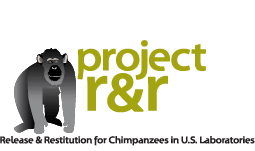August 6, 2013 • Posted in Project R&R News
UPDATE: In June 2015, the U.S. Fish and Wildlife Service announced it would give the same protections to chimpanzees held in captivity as it does their free-living cousins in Africa! Learn more.
August 6, 2013
Public Comments Processing
Attn: FWS-R9-ES-2010-0086
Division of Policy and Directives Management
U.S. Fish and Wildlife Service
4401 N. Fairfax Drive, MS 2042–PDM
Arlington, VA 22203
Comments on Docket No. FWS-R9-ES-2010-0086
Dear Ms. Van Norman,
On behalf of our 25,000 supporters, the New England Anti-Vivisection Society (NEAVS) is submitting comments focused on the use of chimpanzees in invasive research in the United States in response to the U.S. Fish and Wildlife Service’s 12-month finding and proposed rule to eliminate the split-listing of chimpanzees. 78 Fed. Reg. 35201 (June 12, 2013).
Founded in 1895, more than 118 years ago, NEAVS witnessed the tragedy of the first importation of chimpanzees from Africa for behavioral and biomedical research. In the mid-1900s and continuing until their listing under the Endangered Species Act, research facilities, including the U.S. Air Force, were responsible for importation of vast numbers of chimpanzees from the wild. Not only did this harm the captured chimpanzees, but for each chimpanzee captured, family and group members who were attempting to protect the chimpanzee being captured were slaughtered in the process. Translated, this is estimated as anywhere up to 20 other chimpanzees killed or injured during the hunt for a single chimpanzee. Thus, capturing chimpanzees for behavioral and biomedical research was a significant contributor to the precipitous decline of the wild chimpanzee population.
 The cognitive and social needs of chimpanzees, our closest genetic relatives, are indisputable. Chimpanzees such as Tom (pictured here / photo: M. Seres) were captured from the wild and used in research now acknowledged to have limited if any ends for human health. Tom was housed alone in a 5’x5’x7’ cage prior to his rescue to sanctuary. His research history included being terrifyingly “knocked down” (shot with dart guns to be anesthetized) more than 369 times over his 30 years in several different laboratories. He endured chronic psychological and physical stress while in the labs, with multiple symptoms remaining to plague him even long after his rescue. The stress Tom and other chimpanzees endured impacted not only their well-being, but also impaired their physiological suitability for further research.
The cognitive and social needs of chimpanzees, our closest genetic relatives, are indisputable. Chimpanzees such as Tom (pictured here / photo: M. Seres) were captured from the wild and used in research now acknowledged to have limited if any ends for human health. Tom was housed alone in a 5’x5’x7’ cage prior to his rescue to sanctuary. His research history included being terrifyingly “knocked down” (shot with dart guns to be anesthetized) more than 369 times over his 30 years in several different laboratories. He endured chronic psychological and physical stress while in the labs, with multiple symptoms remaining to plague him even long after his rescue. The stress Tom and other chimpanzees endured impacted not only their well-being, but also impaired their physiological suitability for further research.
Chimpanzees endured and continue to endure enormous suffering even though their use in research was and is unnecessary, limited, or misleading. Chimpanzees even turned out to be an unsuitable model for HIV/AIDS, one of the main areas of research in which they were hoped to be useful. In the name of HIV/AIDS research, many wild-caught chimpanzees or their offspring were used to breed what became a decades-long “surplus” of chimpanzees. As explained on page 93 of the March 2010 petition to list all chimpanzees as endangered, this surplus as well as “subjecting this highly cognitive species to invasive biomedical research” promote disrespect for the species and mislead “the public on the conservation status of this species,” thereby undermining conservation efforts. Had they been protected by the endangered status, this surplus of largely elderly, ill, and traumatized chimpanzees may have been avoided.
While we cannot change the history of the U.S.’ treatment of wild and captive chimpanzees, we can use this history to inform current decisions and correct systems that have permitted past errors. In this case, history teaches us that the way forward is to issue and quickly implement a final rule eliminating the split-listing of chimpanzees. The American public is highly sympathetic toward chimpanzees, as the vast public support of efforts to end their use in research for the past seven years attests. Recognizing their need for protection from harmful research or other captive uses reinforces and perhaps awakens in the U.S. public a desire to protect their free-living relatives as well.
Thank you in advance for your decision to promote the conservation and well-being of chimpanzees and award them the status they deserve in our conservation and humane policies, practices, and laws.
Sincerely,
Theodora Capaldo, EdD
President
For more background on the issue, visit "U.S. Fish and Wildlife Proposes New Protective Status for Captive Chimpanzees."

